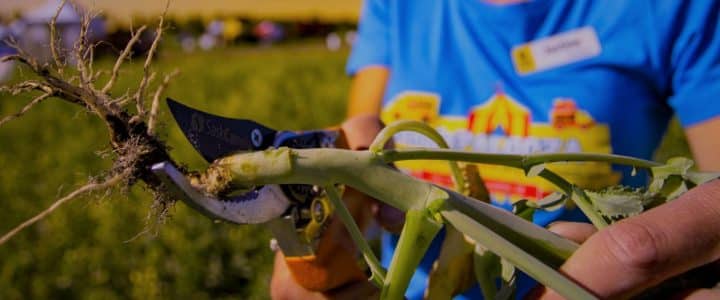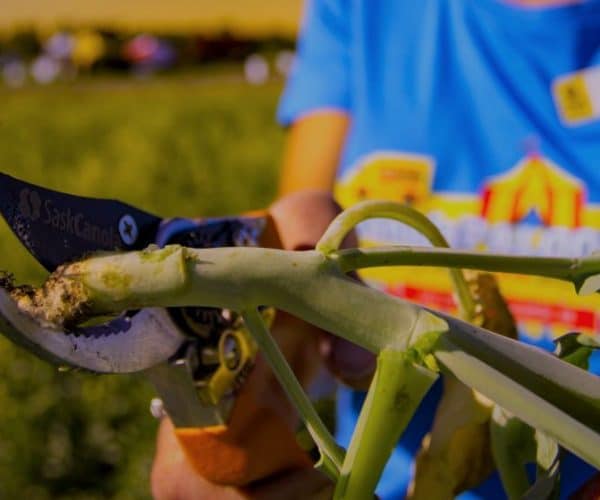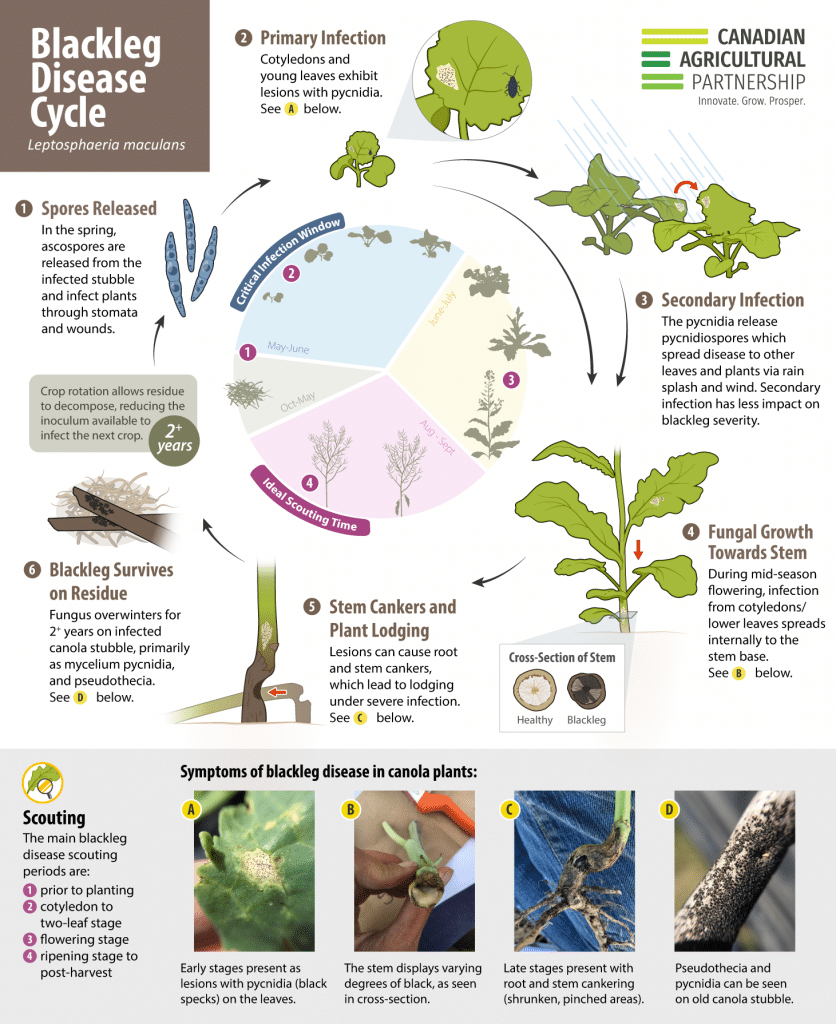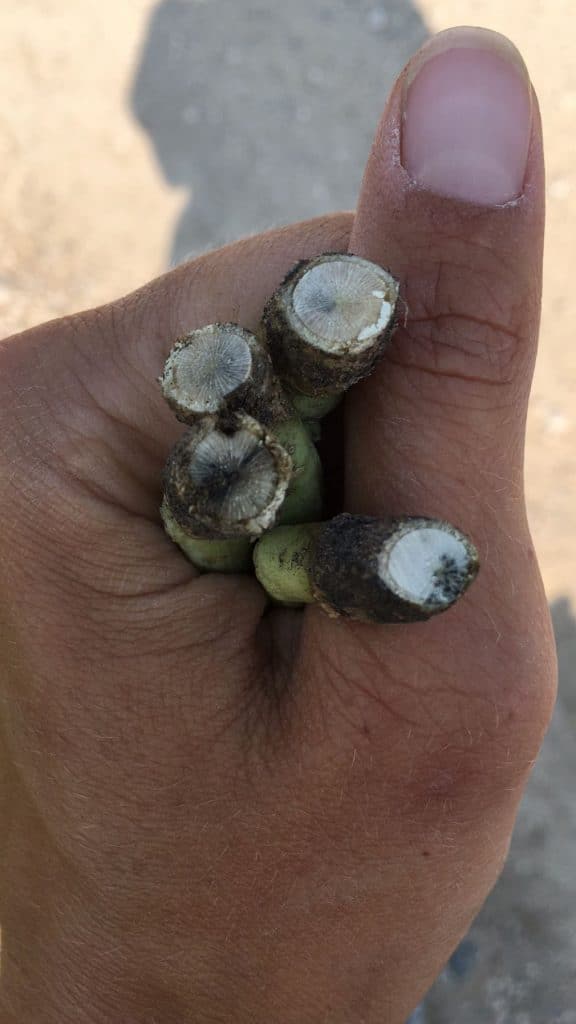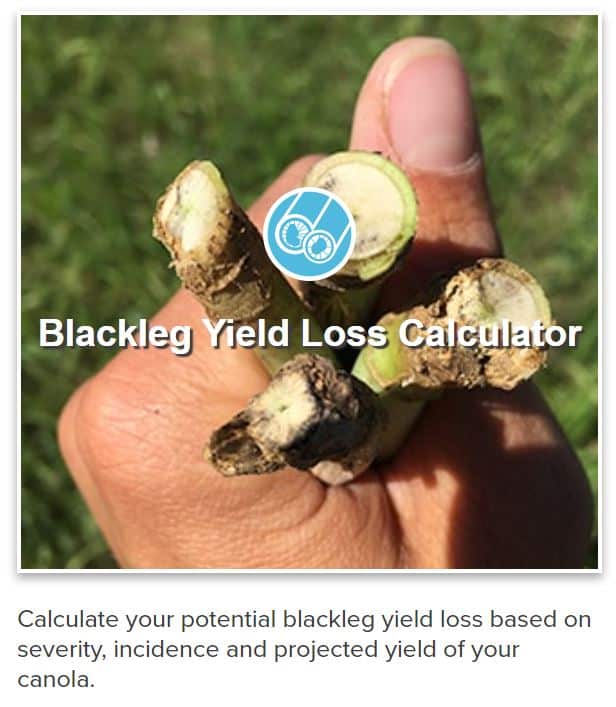Overview of blackleg in canola
Although symptoms can sometime be confused with sclerotinia stem rot or verticillium stripe, blackleg has been a major disease of canola in the Canadian Prairies for several decades. Prevalence and incidence of blackleg (primarily caused by the fungal pathogen Leptosphaeria maculans in Canada) varies between years, but favourable environmental conditions can cause a significant impact on canola yields. A detailed look at the population of the pathogen causing blackleg (and the evolution or adaptation it has gone through) is covered in the 2021 ‘We stand on guard for thee: A brief history of pest surveillance on the Canadian Prairies’ publication.
Genetic resistance was originally introduced in the 1990s and had good success. However, this solution alone wasn’t enough to eliminate the disease. Current management strategies encourage an integrated approach- of which new blackleg resistance is still a key component- for growers in Canada and for our international customers (as is highlighted in Keep it Clean). Some of the key research findings which continue to inform improvements in blackleg management are shared in the projects below.
Key advancements for the blackleg management toolkit
The ‘Canola Disease Management Tools for the Prairies – Blackleg and Sclerotinia’ project, which was made up of several studies, reported these advancements (amongst others):
- Borhan’s study developed a rapid DNA test to identify blackleg races present on canola stubble which was shared with public and private diagnostic labs across Western Canada. Because of this, labs can now provide growers with information on the specific races of blackleg in their field, when they send in blackleg-infected stubble samples, so they can select the appropriate blackleg resistance in their next canola cultivar that best matches the profile of the blackleg race in the field.
- How growers can benefit from these tests is covered in the ‘What growers can do today to support further blackleg knowledge (without any cost)’ section below.
- A collaborative study was able to identify several new blackleg resistance genes, which can be used by seed companies to improve their genetic base.
- Fernando’s study, which was critical for the development of blackleg resistance gene labels, improved knowledge of the durability of some resistance (R) genes used within commercial cultivars. This helped form the foundation for major gene resistance labels now used in blackleg resistance identification (such as in Cornelsen et al.).
- Grower information on R-gene rotation and utilizing blackleg labels is available here.
- The ‘Development of a blackleg yield loss model and assessment of fungicide resistance in Western Canadian populations of Leptosphaeria maculans’ study quantified the relationship between blackleg severity and yield loss, so producers can estimate the amount of yield loss from blackleg in their canola fields, which each unit increase on the severity scale causing approximately 20% loss per infected plant.
- Building on these results, the ‘Yield loss in canola in response to blackleg disease’ paper reported an updated formula to even more accurately calculate blackleg losses in canola, using more current canola varieties (cultivars). This new formula is featured in the online Blackleg yield loss calculator which was produced by the Canola Council of Canada with funding from the Canadian Agricultural Partnership, Alberta Canola and SaskCanola (pictured below).
- The ‘Understanding the mechanisms for race-specific and non-specific resistance for effective use of cultivar resistance against blackleg of canola in Western Canada’ research found that quantitative resistance (QR) plays a role for R-rated canola cultivars. These QR traits are highly useful for blackleg management in Western Canada, even under warmer temperatures between the rosette to early flowering stages.
- Yu’s ‘Introgression of disease resistance from Brassica nigra into canola using new-type Brassica napus’ study used black mustard (B. nigra), which is highly resistant to canola diseases, to find new sources of blackleg resistance genes. They were able to successfully transfer those genes into B. napus breeding lines and made them available to canola breeders.
Further examination of blackleg management topics
Additional completed blackleg-related projects investigating aspects of management include:
- Mitigating the risk of blackleg disease of canola using fungicide strategies (which yielded a 2021 publication called ‘Early fungicide treatment reduces blackleg on canola but yield benefit is realized only on susceptible cultivars under high disease pressure’)
- Optimizing canola production through biological control of virulent strains of blackleg pathogen and insect pests of canola
- Defining populations of the L. maculans pathogen in test sites used for canola blackleg resistance trials
- These blackleg-related projects featured by Alberta Canola and SaskCanola.
Blackleg research conclusions has informed management advice, in many forms
Investigation of blackleg through multiple years of research has increased the knowledge of blackleg, which has fueled the development of many grower resources, both directly via:
- This Understanding Blackleg Resistance and Management Tools video (embedded below)
- A comprehensive Blackleg disease cycle illustration (pictured above)
- The informative and resourceful Blackleg.ca website
Outcomes of multiples studies have also been combined and applied to commercial situations, to provide recommendations directly to canola growers through:
- The Canola Council of Canada’s Understanding Blackleg Resistance guide and the Blackleg Management Guide
- This quick and effective Blackleg scouting video
What growers can do (without any cost) to support blackleg knowledge
In addition to the provincial disease surveys that are completed each year by a combination of government and industry members, and research conducted on incidence and distribution of blackleg (see A six-year investigation of the dynamics of avirulence allele profiles, blackleg incidence, and mating type alleles of Leptosphaeria maculans populations associated with canola crops in Manitoba, Canada for details), canola growers can contribute to the understanding of blackleg by testing their fields.
Submitting samples of disease-infected canola stubble helps growers confirm the presence of blackleg in their field and (if present) to determine what blackleg races exist in a field. This allows growers to make an informed decision about which cultivar they should select in the following year (to best manage their blackleg). In addition, these results provide useful information to the province about the prevalence and distribution of blackleg and specific L. maculans races. Some provinces even offer free tests for canola growers.
- Members of the Manitoba Canola Growers can currently submit samples for free to the Pest Surveillance Initiative (PSI) lab (in Manitoba). PSI also provides the phenotype – how the races in a field may affect the cultivar resistance in that field – to help guide cultivar selection. For details on the submissions, see this PSI Lab information.
- Similarly, SaskCanola is now offering free blackleg disease testing program for registered canola growers in Saskatchewan. See this SaskCanola page for details on how to collect and submit samples to Discovery Seed Labs, as well as results to expect.
- The Alberta Plant Health Lab offers blackleg testing options in Alberta- including some opportunities for free sample submissions.
- Labs that can also offer blackleg testing are listed here.
Future findings to anticipate
The ongoing need for blackleg-related information continues to incite new research on this topic. Check out the focus and objectives of these projects, which are currently under way:
- Understanding the critical infection window that causes blackleg of canola in western Canada
- Improving management of blackleg on canola via better flea beetle control and effective fungicide seed treatment in Western Canada
- Identification and genetic mapping of novel genes for resistance to blackleg in Chinese and Canadian B. napus lines
- Fine-tuning of the blackleg yield loss model in canola
- Genetic dissection of the Rlm3-4-7-9 blackleg R gene cluster and KASP marker improvement
- Monitoring the race dynamics of Leptosphaeria maculans for effective deployment and rotation of resistance genes for sustainable management of blackleg of canola in western Canada
- Investigating interactions of ascospores and pycnidiospores with blackleg resistance in canola and efficacy of seed applied fungicides in these specific interactions in western Canada
- Developing a robust system for efficient assessment of quantitative resistance (QR) in commercial canola lines and varieties for blackleg management
- Towards better understanding of genetics in Leptosphaeria-Brassica interactions via international collaborations to standardize the nomenclature of blackleg resistance genes
- Developing tools for the rapid screening of canola germplasm for quantitative resistance to blackleg disease
- Improving blackleg resistance durability through R-gene rotation in commercial fields on the Canadian prairies: a science based stewardship program
- Exploring novel seed treatment options to mitigate the impact of blackleg on canola
- Building bridges to success – accessing Brassica diploid variation for canola improvement
- An on-farm approach to monitor and evaluate the interaction of management and environment on canola stand establishment and disease development
More canola disease-related studies are available on the Canola Research Hub.
Published August 13, 2021


